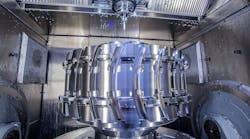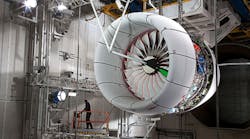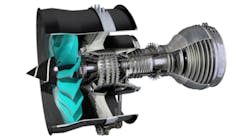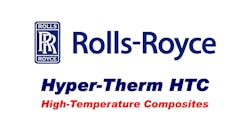Rolls-Royce Plc opened an advanced manufacturing plant in northeast England recently, a £100-million (est. $172 million), the 18,000-m2 operation devoted to producing aerospace discs for its Trent XWB jet engines. The engine builder will continue developing the new installation until it reaches full production capacity in 2016, with a capacity for 2,500 fan and turbine discs per year.
“Rolls-Royce is committed to investing for future growth in order to deliver for our customers,” stated Tony Wood, president of Aerospace for the engine builder. “We invested £687 million (est. $1.2 billion) in facilities and equipment around the world last year. This facility will use groundbreaking manufacturing techniques to produce discs for our Trent engines, including the world’s most efficient aero engine, the Trent XWB.”
Fan discs and turbine discs are core components of turbofan jet engines. The Trent XWB is an engine that Rolls developed specifically for the Airbus A350 XWB, and over 1,600 have already been sold, though the jets will not have a commercial debut until later this year. The A350 XWB is a version of Airbus’ new long-range, dual engine wide-body jets designed with fuselage and wing structures produced in lightweight, carbon-fiber-reinforced polymer (CFRP) materials. They are designed to carry up to 550 passengers, depending on the model variant and seating arrangement.
While jet engines are Rolls-Royce’s signature product, the plant is being developed to produce some of its engines’ critical parts. Fan discs are installed in the front, air-intake part of the engine and the element to which fan blades are attached —typically 20 blades per engine. They rotate at a speed estimated as 2,700 times per minute to move 1.25 metric tons of air per second. They are designed to remain in service for over 20 years.
Turbine discs are the components to which turbine blades are attached, in the center (i.e., the hottest part) of the engine. Thus, they must be machined from a high-strength material to endure high heat and high pressure created during flight. The material is formed from a high-density powder metal that is processed and machined to extraordinary accuracy, “a fraction of the thickness of a human hair,” according to Rolls-Royce.
Each turbine disc is fitted with 68 turbine blades, and each of these blades generates power equivalent to a Formula 1 race car, again according to Rolls’ description.
In operation, each high-pressure turbine engine rises to 1,700°C, hotter than the melting point of the blade material. As such, each blade is coated with a specially developed ceramic, and cooled with air that passes through the discs out of the engine chamber through a series of holes in the blade — each hole precisely placed and precisely drilled.
The new machining operation is located in a town called Washington, and its significance to Rolls-Royce is also evidenced by the new robotic and automation technologies in place there. These include automated systems for shot-peening, painting, and chemical processing.
The plant also is home to advanced machining, grinding, broaching and inspection processes, which will cut in half the manufacturing time for a disc. The new plant is adopting some manufacturing methods developed at the Advanced Manufacturing Research Centre (AMRC) in Rotherham, England, part of a network of research centers that work with U.K. businesses to commercialize university research into new manufacturing technologies.









